Lessico
Tordo
In latino turdus,
in greco kíchlë oppure kíchla. Nome comune degli uccelli
passeriformi della famiglia Turdidi. Anche il merlo![]() , Turdus
merula, appartiene alla famiglia Turdidi.
, Turdus
merula, appartiene alla famiglia Turdidi.
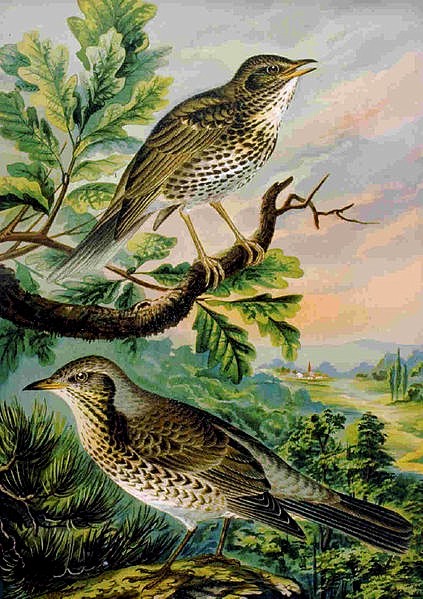
Tordo bottaccio - Turdus philomelos
Il tordo bottaccio (Turdus philomelos) è lungo 22 cm, possiede ali ben sviluppate, testa allungata con becco diritto,. zampe alte con dita robuste. Il piumaggio, denso e morbido, è bruno dorsalmente e biancastro inferiormente, con petto, ventre e lati del collo percorsi da serie longitudinali di macchie brune. Frequenta aree con alberi e fitti cespugli. Si nutre di bacche, frutta, semi, insetti, molluschi e vermi. Si riproduce in aprile e costruisce un nido a forma di coppa, situato nei cespugli, tra l'edera, nelle siepi. Il canto è molto melodioso e sonoro. È diffuso in quasi tutta l'Europa, in gran parte dell'Asia centrale e settentrionale, donde migra a sud verso l'autunno.
Lievemente più piccolo e di aspetto simile è il tordo sassello (Turdus iliacus), che presenta fianchi e superfici inferiori delle ali rossicci, petto e fianchi striati di bruno, sopracciglia di colore crema; frequenta di preferenza le campagne aperte e i boschi non molto fitti.
Altre
specie di tordo che si possono rinvenire talvolta in Italia sono il tordo
oscuro (Turdus obscurus), il tordo a gola nera (Turdus ruficollis),
il tordo dorato (Turdus dauma), il tordo americano (Turdus
migratorius![]() ),
comunissimo in tutto il Nordamerica, dove è noto con il nome di Robin.
),
comunissimo in tutto il Nordamerica, dove è noto con il nome di Robin.
La carne del tordo, piacevolmente grassa, è gustosa; particolarmente apprezzati gli esemplari che si sono cibati di bacche aromatiche e di olive. Si cucinano arrosto, allo spiedo, ripieni. Con i tordi, come con i merli, si prepara un ottimo paté.
Song
Thrush
Turdus philomelos
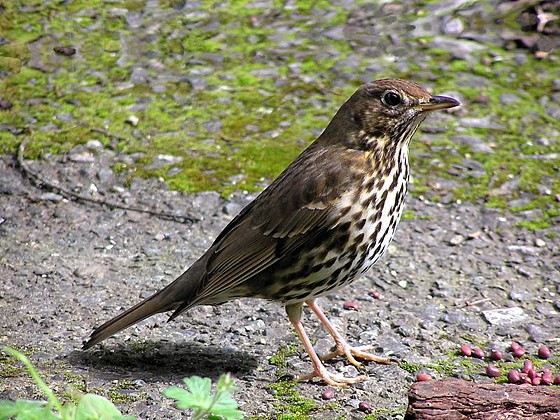
The Song Thrush (Turdus philomelos), also known in dialects as a throstle, or mavis is a common European member of the thrush family Turdidae. It is commonly found in well-vegetated woods and gardens over all of Europe south of the Arctic circle, except Iberia. They have also been introduced to New Zealand and Australia. They are common and widespread in NZ however in Australia only a small population around Melbourne survives. Many birds move south during the winter, although some western populations are resident. This species has also been introduced in other parts of the world.
Song Thrushes are omnivorous, eating a wide range of insects, earthworms, snails and berries. They often use a favourite stone as an "anvil" to smash snail shells against. They do not form flocks, although several birds may be loosely associated in suitable habitat.
Song Thrushes, at about 22–23 cm long and 70–90 g in weight, are smaller than Blackbirds, Turdus merula. Sexes are similar, with plain brown backs and neatly spotted underparts. The breast is washed with buff.
They nest in bushes or hedges, laying four or five eggs (bright glossy blue with black spots) in a neat cup-shaped nest lined with clay. The female incubates for about 14 days; the young fledge in about the same time. Song Thrushes may raise two or three broods in a year.
The male sings its loud song from trees, rooftops or other elevated perches. The song characteristically repeats melodic phrases, as described by Robert Browning in the poem "Home Thoughts, from Abroad":
Hark,
where my blossom'd pear-tree in the hedge
Leans to the field and scatters on the clover
Blossoms and dewdrops – at the bent spray's edge –
That's the wise thrush; he sings each song twice over,
Lest you should think he never could recapture
The first fine careless rapture!
although repeating the phrases three times (rather than twice as suggested by Browning) is more common.
The Song Thrush is the emblem of West Bromwich Albion Football Club.
Tordela
Turdus viscivorus
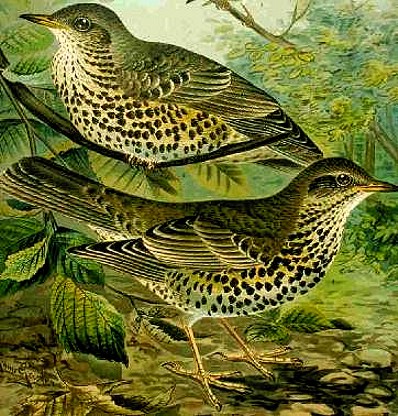
La tordela (Turdus viscivorus, Linnaeus 1758) è un uccello della famiglia dei Turdidae, che si trova in quasi tutta l'Italia, esclusa la pianura padana. Ne sono note quattro sottospecie. Dal punto di vista estetico è quasi identico al tordo bottaccio, infatti tranne per il fatto che è di taglia molto più grande, e che in volo il sottoala della tordela è bianco (color camoscio nel tordo bottaccio), sono identici. Coda e dorso di colore marrone chiaro, fianchi e petto di colore chiaro, quasi bianco, con i classici puntini neri dei tordi, su petto e ventre.
La tordela la si trova in una buona aperte dell'Asia, dell'Europa, e dell'Africa del Nord, in habitat costituiti da boschi radi, di latifoglie e conifere, d'inverno si sposta verso ambienti più aperti come prati e campi coltivati. In Italia nidifica in estate in alta quota, spostandosi nella stagione invernale in zone con clima più mite. Come tutti i tordi, ama trovare il cibo per terra, quindi lo si vede saltellare sui prati cercando insetti, ma è anche ghiotto di frutta e gemme.
Dopo che si è formata la coppia, nidifica come tutti i tordi da aprile a luglio, depone in media 5 uova di colore azzurrino, con macchie rossicce.
Tordo
sassello
Turdus iliacus
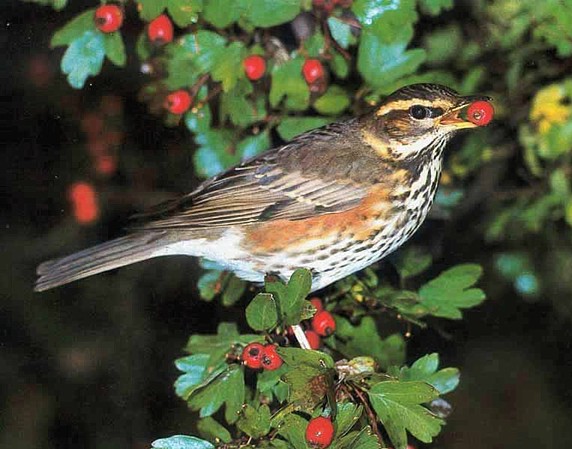
Il tordo sassello ha dimensioni medio-piccole, forme piuttosto slanciate, becco robusto, coda di media lunghezza e quadrata, tarsi lunghi. In entrambi i sessi il piumaggio è di colore bruno-olivastro scuro nelle parti superiori, bianco-fulvo striato di scuro nelle parti inferiori, sopracciglio crema, fianchi e ascellari castani, coda marrone scuro con punta delle piume bianco-fulvicce.
In volo, visto da sotto, è riconoscibile per la colorazione castana sotto le ali e la striatura del petto e dei fianchi. Dalla cesena – Turdus pilaris - si riconosce per le minori dimensioni, mentre per le dimensioni e le forme pressoché identiche è facilmente confondibile con il tordo bottaccio. Lunghezza cm. 21-22, peso gr. 50-75.
www.ittiofauna.org
Cesena
Turdus pilaris
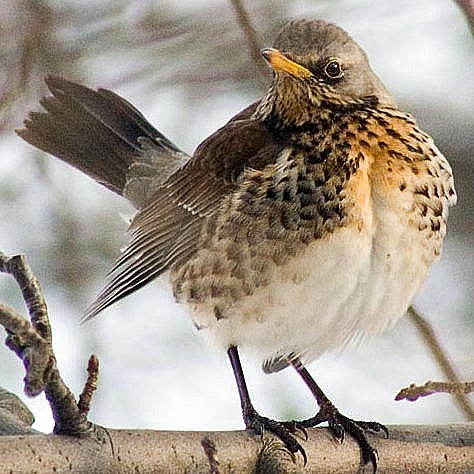
La cesena (Turdus pilaris, Linnaeus 1758) è un uccello della famiglia dei Turdidae, che si trova in Italia sulle Alpi. Non se ne conoscono sottospecie.
Si riconosce dagli altri tordi, per la grandezza come quella di un merlo (taglia di 28 cm, e quasi 100 grammi di peso), per la testa e il groppone grigio, il petto è bianco con i classici puntini neri dei tordi, dorso castano e coda nera.
Lo si trova in Europa nord-orientale e Asia settentrionale; in Italia ne esistono diverse coppie sulle Alpi, comunque migrano nei paesi caldi per l'inverno, compresa l'Africa del Nord. Preferisce le zone rade, non ricche di alberi, ai margini dei boschi.
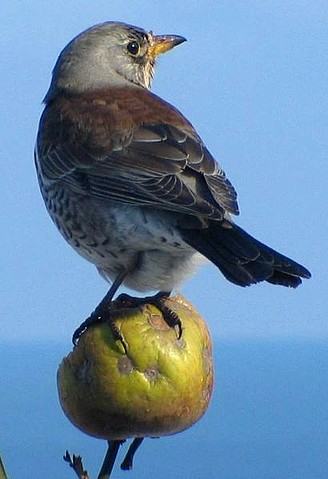
Si riproduce tra aprile e luglio, nidifica in colonia, sulle cime degli alberi, depone 5 o 6 uova, che si schiudono dopo due settimane, altre due settimane occorrono per vedere uscire i pulli dal nido. In genere riesce a completare due covate in un anno.
American
Robin
Turdus migratorius
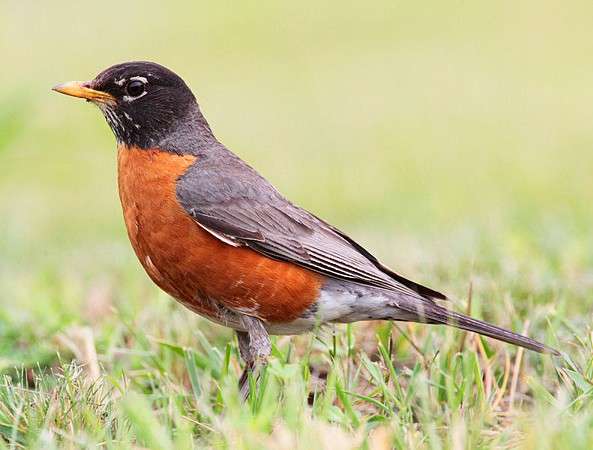
The American Robin (Turdus migratorius) is a migratory songbird of the thrush family. The similarity between the orange-red coloring of its breast to that of the smaller and unrelated European Robin (Erithacus rubecula) led to its common name. The American Robin is the state bird of Connecticut, Michigan, and Wisconsin.
The American Robin is 23–28 cm (10–11 in) long, averaging about 77 g (2.7 oz), with a wingspan ranging from 119 to 137 millimeters. In the wild, the longest known lifespan of an American Robin is 14 years, but the average lifespan is about 2 years. It has a brown back with a reddish-orange breast. It is white underneath the tail feathers and on the lower belly. The throat is white with black streaks, and males are generally brighter than females. It has a small yellow beak and distinctive crescents around the eyes. There are seven sub-species, but only T. m. confinus in the southwest is particularly distinctive, with pale gray-brown underparts. Juveniles are paler in color than adult males and have dark spots on their breasts.
During the
breeding season, the adult males grow distinctive black feathers on their
heads; after the breeding season they lose this eye-catching plumage.
This bird breeds throughout most of North America, from Alaska and Canada
southward to northern Florida and Mexico. While Robins occasionally overwinter
in the northern part of the United States and southern Canada, most winter
south of Canada from Florida and the Gulf Coast to central Mexico, as well as
along the Pacific Coast. Most depart south by the end of August and begin to
return north in February and March (exact dates vary with latitude and climate).
This species is a very rare vagrant to western Europe.
However, in autumn 2003, migration was displaced eastwards leading to massive movements through the eastern USA. Presumably this is what led to no fewer than three American Robins being found in Great Britain, with two attempting to overwinter in 2003–2004, one of which was taken by a Eurasian Sparrowhawk, and one sighted in Britain in January 2007 in Gilstead, West Yorkshire, England. The American Robin's habitat is woodland and more open farmland and urban areas.
The American Robin is active mostly during the day, assembling in large flocks at night, roosting in trees in secluded swamps or dense vegetation. In the winter, they gather in large numbers on their winter grounds, breaking up during the day to feed on fruits and berries in smaller flocks. During the summer, American Robins defend breeding territories and are less social during that time.
Robins are frequently seen running across lawns, picking up earthworms by sight. In fact, the running and stopping behavior is a distinguishing characteristic. When stopping, they are actually looking for prey, not listening.
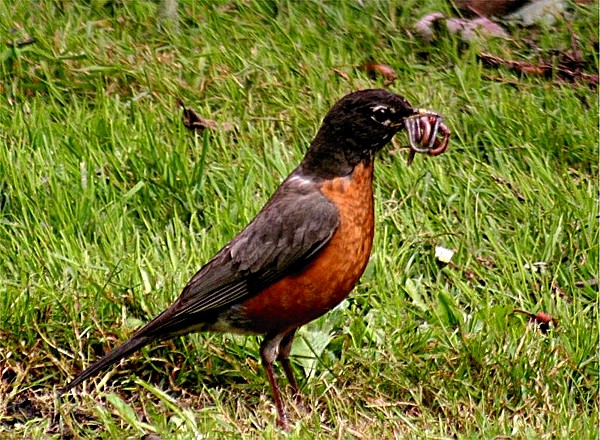
American Robin diet generally consists of around 40 percent invertebrates, such as beetle grubs, caterpillars, and grasshoppers, and 60 percent fruits and berries.[3] It feeds on a mixture of both wild and cultivated fruits and berries. It forages primarily on the ground for soft-bodied invertebrates, and finds worms by sight, pouncing on them and then pulling them up.
Juvenile robins and eggs are preyed upon by squirrels, snakes, and some birds, such as Blue Jays, Common Grackles, American Crows, and Common Ravens. Adults are primarily taken by hawks, cats, and larger snakes, although when feeding in flocks, the American Robin is able to remain vigilant and watch other flock members for reactions to predators.
The American Robin begins to breed shortly after returning to its summer range from their winter range. It is one of the first bird species to lay eggs, and normally has two to three broods per breeding season.The breeding season lasts from April to July.
Nests are most commonly located five to fifteen feet above the ground in a dense bush or in a fork between two tree branches, and is built by the female. The outer foundation consists of long coarse grass, twigs, paper, and feathers, lined with smeared mud and cushioned with fine grass or other soft materials. New nests are built for each brood, and in northern areas the first clutch is usually placed in an evergreen tree or shrub while later broods are placed in deciduous trees.
A clutch consists of three to five light blue eggs, and is incubated by the female. Eggs hatch after 14 days and chicks leave the nest two weeks later. All chicks in a brood leave the nest within two days of each other. While the chicks are still young, the mother broods them continuously but will brood them only at night or during bad weather when they are older. Even after leaving the nest, the juveniles will follow their parents around and beg food from them. Juveniles become capable of sustained flight two weeks after fledging.
The eyes of the pink featherless nestlings are closed for the first five days. Both parents feed the nestlings a diet of earthworms, insects, and berries.
The adult male and female both are active in protecting and feeding the fledged chicks until they learn to forage on their own. The adult Robins give alarm calls and dive-bomb predators, including domestic cats, dogs and humans, that come near the young birds. The fledglings are able to fly short distances after leaving the nest. The wings of juvenile birds develop rapidly and it only takes a couple of weeks for them to become proficient at flying. The cryptic young birds perch in bushes or trees for protection from predators. Bird banders have found that only 25% of young robins survive the first year. The American Robins are not shy about nesting close to human habitation.
The male American Robin, as with many thrushes, has a beautiful, complex and almost continuous song. Its song is commonly described as a cheerily carol, made up of discrete units, often repeated, and spliced together into a string with brief pauses in between. The song varies regionally, and its style varies by time of day. American Robins will often be among the first songbirds singing as dawn rises, and last as evening sets in.
In addition to its song, the American Robin has a number of calls used for communicating specific information. When a ground predator approaches but does not directly threaten, Robins will make a PEEK!! tut tut tut tut... warning call. When a nest or Robin is being directly threatened, another call is used, which sounds like a horse's whinny. Even during nesting season, when Robins exhibit mostly competitive and territorial behavior, they may still band together to drive away a predator. Robins also make a very high-pitched sound when a hawk or other bird of prey is seen; other robins will repeat the sound, seek cover, and stop moving. During the colder parts of the year, the American Robin gathers in flocks around food sources, and there is yet another call that is heard in such flocks.
The Disney film Mary Poppins, set in London, incorrectly portrayed American Robins singing by an open window, despite the fact that the European Robin is the only bird named as a robin to be commonly found in the United Kingdom. Additionally, both robins building the nest in that film are males.